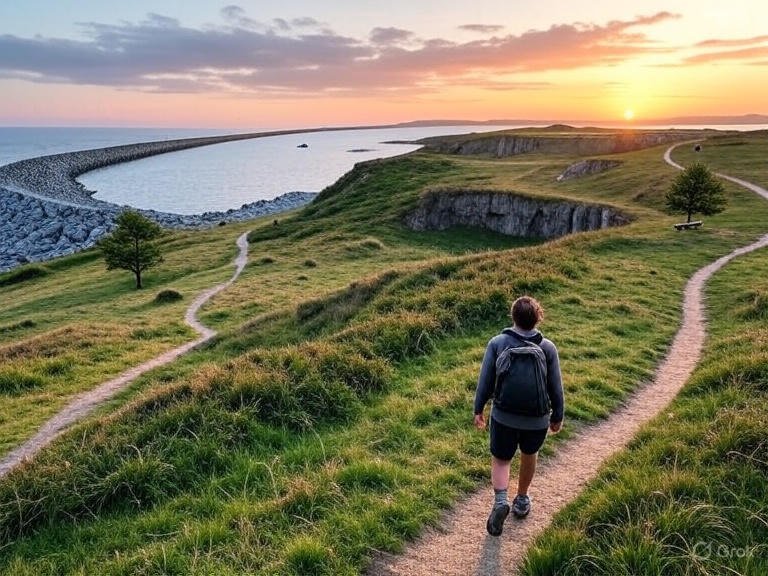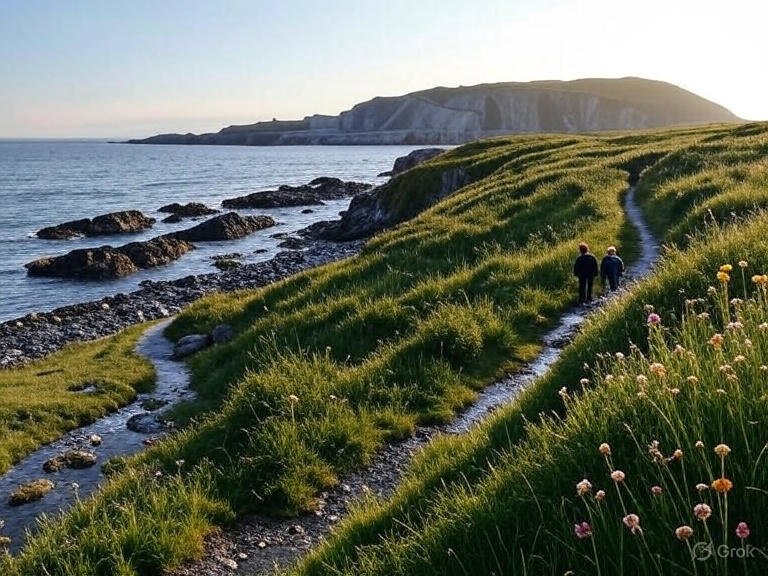Holyhead Breakwater Country Park is a nice place on Anglesey, Wales. It’s next to the sea, near Holyhead town. The park has pretty views, fun walks, and old stories. Long ago, it was a quarry that made a big sea wall. Now, it’s a quiet spot to walk, see animals, and learn about history. This article tells you about the park’s paths, quarry secrets, and cool animals. I’m Warren Driscoll. I’ve been to fancy places like Ibiza and the French Alps since 2018. I share real tips and my own photos to help you plan a fun trip. Let’s go see the park!
Why Visit Holyhead Breakwater Country Park?
This park is special. It has nature, history, and fun things to do. You can walk by cliffs, see old quarry stuff, and watch birds like fast falcons. It’s good for kids, walkers, or anyone who likes being outside. The park is big, about 106 acres, and in a very pretty area called an Area of Outstanding Natural Beauty (AONB). It’s easy to get to from Holyhead town by car or a short walk. If you want an easy walk or a hard hike, this park has it.
Coastal Trails: Walking by the Sea
The park joins a famous sea path called the Anglesey Coastal Path. These paths show you the Irish Sea, Holyhead Mountain, and small islands called the Skerries. The walks are easy or a bit harder, so everyone can try them. Here are the main paths and why they’re fun.
The Rocky Coast Trail
This path is loved because it’s so pretty. It goes by cliffs next to the sea. You hear waves hit rocks and smell the sea air. The path is mostly flat but can be bumpy, so wear good shoes. You’ll see a memorial for a 1944 plane crash called the B24. It has a plane propeller to remember American soldiers. This walk takes 1 hour and is great for kids or easy walkers.
Holyhead Mountain Loop
This path is more fun for adventure. It’s 3.6 miles long and goes up Holyhead Mountain, which is 220 meters tall. The views are great! On clear days, you see Snowdonia, the Isle of Man, and even Ireland. The path is steep and rocky sometimes, so it’s for strong walkers. You pass an old fort called Caer y Twr, made by Romans long ago. This walk takes 2 to 2.5 hours. Bring water and check the weather because it can be windy.
South Stack Lighthouse Route
This path goes to South Stack Lighthouse, 2 miles from the park. The lighthouse, built in 1809, is on a small island. You climb 400 steps to get there, but the views are awesome! You see cliffs and maybe seals in the water. A place nearby called RSPB South Stack is great for seeing birds. This walk is a bit hard and takes 1.5 hours one way. If you love nature, you’ll like this.
North Stack and Fog Signal Station
This path goes north to North Stack and an old fog signal station. It has big views of Holyhead and the Skerries Lighthouse. It’s not as steep as the mountain path but still pretty. Look for a hidden cave called Parliament House Cave by the cliffs. This walk takes 1 hour to go and come back and is good for most people.
Quarry Secrets: Old Stories
The park used to be a quarry. It gave 7 million tonnes of stone to build Holyhead’s breakwater from 1846 to 1873. This breakwater is the longest in Europe, 1.5 miles long, and keeps the port safe. After the quarry closed in 1875, it made bricks until 1975. Now, you can see bits of this history. Here’s what to look for.
The Brickshed and Crusher Building
You can visit the old brickshed and crusher building. The brickshed has a gallery with photos of animals and views. The crusher building shows where stones were broken for bricks. Signs tell you about the quarry’s past, so you can think of workers there long ago. These are near the park’s entrance, so they’re easy to see.
Pwll Clai: The Water Lake
Pwll Clai is a lake made from an old clay pit that filled with water. It’s a calm place to fish or watch ducks and birds. The lake is near the visitor center, and a short path goes around it. Kids will like seeing nature and learning about the quarry.
WWII History: The B24 Memorial
In 1944, an American plane called “Jig’s Up” crashed near the park. A propeller from the plane is in a memorial by the North Stack path. It’s a sad place to remember WWII soldiers. If you want to see it, take a taxi from Holyhead station because it’s far to walk. The memorial is easy to find by the sea path.
Old Ruins and Ancient Places
The park is near old places that add to its history. The Caer y Twr fort on Holyhead Mountain is an old ruin with a Roman watchtower. Nearby, the Holyhead Mountain Hut Circles show how people lived long ago. You can reach these on the mountain path. They’re great for people who like history.
Local Wildlife: Animals and Nature

The park is full of animals because it has cliffs, fields, and lakes. It’s in a pretty area and near special science places (SSSIs). I’ve seen nature in places like the French Alps, and this park is great for animals. Here’s what you might see.
Birds to See
The park is awesome for watching birds, especially in spring and autumn. Look for:
- Choughs: These birds have red beaks and fly over cliffs. They’re rare and fun.
- Peregrine Falcons: These are the fastest birds. They dive to catch food.
- Seabirds: Puffins, guillemots, and razorbills live near South Stack. Bring binoculars to see them.
- Swallows and Swifts: These birds come in summer and fly fast over fields.
Seals and Sea Animals
You might see grey seals in the water by the park. They’re common in autumn when baby seals are born. Look for them on the South Stack path. Sometimes, porpoises swim in the Irish Sea. Stay far away so you don’t scare them.
Flowers and Plants
In summer, the park has bright flowers. Gorse and heather make the paths colorful. The park uses ponies to eat grass and keep the fields nice. These flowers bring bees and butterflies, which are fun to see.
Tips for Visiting
Here are easy tips to make your trip fun, from my travel experience:
- Getting There: The park is 2 miles from Holyhead town. Drive past the breakwater or take a taxi from the train station. Parking costs about £1 for 4 hours.
- Things to Use: There’s a café, toilets, and a visitor center with displays about animals and history. The café might close early, so bring snacks. The visitor center may close in winter.
- Easy Paths: Some paths, like around Pwll Clai, are flat for wheelchairs. Cliff paths can be muddy or rocky, so check if walking is hard for you.
- Best Time to Visit: Spring and autumn are good for birds. Summer has flowers and warm weather. The park is open all year, but winter paths can be slippery.
- Stay Safe: Wear strong shoes for rocky paths. Keep dogs on a leash near cliffs or horses. Check tide times if you’re by the sea.
Why This Park Is Special
This park is different from other sea parks. It has quarry bits that tell old stories. The paths lead to ancient ruins and new memorials. The animals, like falcons and seals, make walks fun. It’s not too busy, so you can enjoy quiet time. I’ve seen fancy places like Saint-Tropez, but this park’s nature and history are special.
How to Plan Your Trip
Start at the visitor center for a map. Pick a path that fits you—Rocky Coast for an easy walk, Holyhead Mountain for a hard one. Bring a camera for views and binoculars for birds. Pack a picnic for Pwll Clai lake. To see the B24 memorial, start at the North Stack path. Plan 2–4 hours to explore, or more for South Stack. Check the weather because it changes fast by the sea.
Connecting with Others
Locals and visitors love this park. People on TripAdvisor say the views and walks are great. Some want better path signs, but most find them easy. The café and staff, like ranger Will and volunteer Charlotte, are nice. Share your trip on social media or write a review to help others find this place.
Conclusion
Holyhead Breakwater Country Park is a gem on Anglesey’s coast. Its paths have great views, its quarry has cool history, and its animals make nature fun. Whether you walk to South Stack, visit the brickshed, or see seals, there’s something for everyone. I’m Warren Driscoll, and I’ve seen many pretty places. This park’s nature and history are special. Go visit and see it yourself.
Explore More
- Park Durmitor Montenegro: Untouched Wilderness, Secret Spots & Scenic Adventures (2025)
- Herdwick Croft Caravan Park Reviews: Simple Guide with Guest Stories and 2025 Tips

Warren Driscoll writes about luxury travel. He has over seven years of experience. Since 2018, he has stayed in private villas in Ibiza and Saint-Tropez, and chalets in the French Alps. Warren’s stories have been shared by Indvidual Magazine. He writes honest reviews and gives helpful tips to help people plan great holidays. He also shares his own photos and real experiences to make his advice clear and useful.
